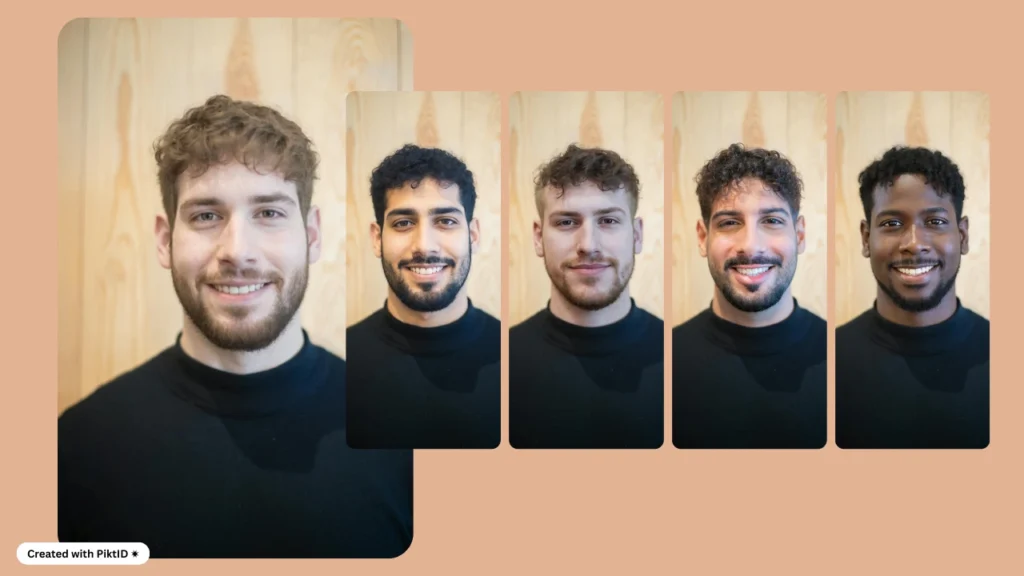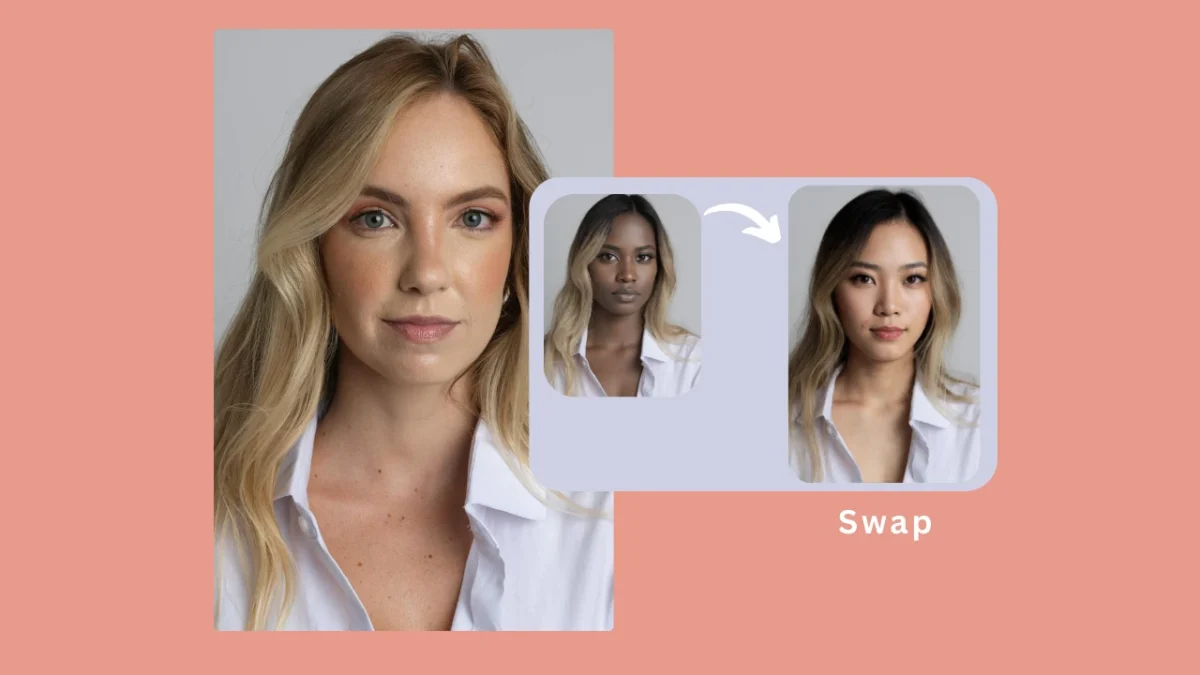1. Getting Started with Face Swap
Face swap technology has rapidly evolved from a niche experiment into a widely adopted tool across industries. At its core, it allows one person’s facial features to be replaced with another’s in photos or videos, but modern AI advancements have taken it far beyond basic overlays. With high-precision algorithms, it’s now possible to create swaps that are nearly indistinguishable from reality.
PiktID takes this innovation further by focusing on three essential pillars of realism:
- Skin tone matching to ensure natural transitions between original and swapped areas
- Accurate lighting integration so that shadows, highlights, and ambient tones remain consistent
- Seamless hair blending to avoid visible edges or unnatural textures
These refinements make PiktID’s approach highly adaptable for industries where authenticity matters. Content creators use it to enhance storytelling, e-commerce brands personalize shopping experiences by showcasing products with different models, marketers localize campaigns for global audiences, and social media platforms offer unique personalization features for users.
The rise of face swap technology is transforming how visuals are produced, shifting from labor-intensive manual editing to AI-powered workflows that deliver consistent, high-quality results in seconds.
2. What is Face Swap Technology?

Face swap technology is a process that uses artificial intelligence to detect, map, and replace a subject’s facial features with another’s while preserving the original image’s overall structure and context. At a technical level, it relies on:
- Facial landmark detection to identify key reference points such as eyes, nose, and mouth
- Neural networks trained on large datasets to predict realistic facial transformations
- Blending algorithms to merge skin texture, color, and lighting between source and target faces
The early versions of this technology appeared in novelty applications, often producing unrealistic or comedic effects. Over the years, advancements in machine learning and computer vision have elevated it into a professional-grade editing tool capable of meeting production-level demands.
A critical aspect of its evolution is the focus on realism. Poorly executed swaps can create the “uncanny valley” effect, where subtle inconsistencies in texture, lighting, or facial proportion make an image feel unnatural. High-quality systems like PiktID prioritize detail-oriented processing, ensuring results are both convincing and visually coherent—making them suitable for commercial use, media production, and creative projects that require professional polish.
Try out our Body Swap AI using PiktID.
3. PiktID’s Face Swap Feature: A Technical Deep-Dive
PiktID’s face swap feature is powered by advanced Face Swap Technology designed to produce results that are nearly indistinguishable from genuine photographs. By combining multiple AI models, the system ensures that each swap not only replaces a face but also preserves the integrity of the surrounding image.

Core Differentiators
- Lighting and Shadow Consistency
The AI analyzes the source and target images to match light direction, shadow intensity, and overall exposure. This ensures that swapped faces blend seamlessly without appearing artificially inserted. - Skin Tone Calibration
PiktID’s Face Swap Technology automatically adjusts skin tones to match the surrounding body and environment. This eliminates the mismatched tones that are common with less sophisticated tools. - Hair and Edge Integration
The system accurately maps hairlines, stray strands, and fine edges, avoiding the “cut-out” look often seen in manual editing.
Compared to Manual Photoshop Work
While traditional Photoshop techniques can produce good results, they require hours of manual adjustments. PiktID delivers similar or better accuracy in a matter of seconds, with far less technical skill required from the user. You can use PiktID to Insert Face using AI.
4. Step-by-Step Guide to Using PiktID Swap

Step 1: Load an Image
Upload your own photo or select from PiktID’s sample gallery. High-resolution images with good lighting deliver the best outcomes.
Step 2: Pick Faces to Swap
Using the control panel on the right-hand side, select the target faces. The system detects faces automatically, making selection fast and precise.

Step 3: Edit Advanced Settings (Optional)
Fine-tune individual swaps by adjusting parameters such as alignment, scaling, and skin tone blending. Advanced controls allow for even greater realism.
Step 4: Swap!

Click “Swap now!” and within seconds, your processed image appears in the original upload area. The AI applies all blending, lighting, and edge adjustments instantly.
Practical Tips for Best Results
- Use high-resolution images for both source and target faces.
- Ensure even, natural lighting in your images.
- Frontal face angles work best for maintaining proportions.
PiktID’s Face Swap Technology combines speed, accuracy, and ease of use—making it a powerful solution for content creators, designers, and developers looking to integrate realistic face swaps into their workflows.
5. Real-World Use Cases
Face Swap Technology has evolved beyond novelty filters, becoming a valuable tool in multiple industries. By combining accuracy, speed, and creative flexibility, it empowers businesses and creators to achieve more with less effort.

a. Content Creation
- Enables marketers and creators to produce personalized social media campaigns.
- Allows dynamic replacement of faces in promotional materials without costly reshoots.
- Helps influencers adapt their visuals for different demographics or markets quickly.
b. E-Commerce
- Supports virtual modeling for apparel, eye wear, or accessories.
- Lets customers preview products on different models for a more inclusive shopping experience.
- Reduces the need for multiple photo shoots, saving time and cost.

c. Film & Media
- Used for rapid prototyping of character appearances during pre-production.
- Simplifies casting mock ups by placing actors into roles digitally before filming.
d. Education & Research
- Enables safe data augmentation for facial recognition training.
- Protects privacy while creating realistic test datasets for academic studies.

6. Face Swap vs. Anonymize – Choosing the Right Tool
When deciding between Face Swap Technology and anonymization, it’s important to match the method to your use case.

i. Face Swap
- Replaces an existing face with a user-supplied identity.
- Ideal for personalization, creative projects, or brand campaigns where the face must match a known individual.
- Learn more about Swap

ii. Anonymize
- Replaces a face with an AI-generated, privacy-compliant alternative.
- Best for GDPR compliance, anonymizing datasets, or protecting identities in public-facing media.
- Learn more about Anonymize
By understanding the strengths of each approach, you can select the right solution for your workflow—whether it’s personalizing visual content or ensuring privacy in sensitive datasets.
7. Tips & Best Practices

To achieve the most realistic and seamless results with face swap technology, attention to input quality is essential. Follow these guidelines to maximize output quality:
- Match lighting conditions: Use images where both the source and target faces share similar lighting and shadow intensity. This ensures smoother skin tone transitions.
- Align facial angles: Keep both images as close as possible in head position and gaze direction. Misaligned angles often require more AI correction and can impact realism.
- Use high-resolution images: Avoid overly compressed or pixelated files, as these reduce the AI’s ability to map details accurately.
- Choose natural expressions: When possible, select source images with a neutral or matching expression to the target image for more convincing integration.
By preparing your images with these considerations, PiktID’s face replacer technology can deliver precise, lifelike composites in seconds.
8. Why Choose PiktID’s Face Swap Technology?

PiktID stands out as a leader in face swap technology by combining high-speed processing, visual accuracy, and robust privacy compliance. This ensures both creative flexibility and secure handling of all images.
Key advantages include:
- Fast processing: Most swaps complete within seconds, even at high resolution.
- Consistent quality: AI-driven facial mapping maintains lighting, skin tone, and hair integration for natural-looking results.
- Privacy-focused design: All workflows comply with GDPR and similar privacy standards, making it suitable for enterprise and personal use.
- Developer-ready API: Automate bulk face swaps or integrate the technology directly into applications and platforms.
With 10 free trial credits available, you can experience the speed and realism of PiktID’s face swap editor before committing to a subscription.
9. Best Face Swap Tool - PiktID

PiktID is the best face swap platform that offers a seamless blend of realism, speed, and ease of use, making it an invaluable tool for both creative and professional applications. Whether you’re building marketing visuals, anonymizing identities, or experimenting with artistic projects, the platform delivers consistent, high-quality results.
By combining advanced AI algorithms with intuitive controls, PiktID ensures that even complex swaps preserve natural lighting, skin tones, and facial expressions. This balance between automation and accuracy is what makes the technology stand out for developers, designers, and everyday users alike.
10. Claim your 10 free Credits

Experience the potential of PiktID’s face swap technology with 10 free credits to start. Test its capabilities through the user-friendly Studio or integrate it directly into your own applications via the API.
- Try it here: PiktID Face Swap
- Developer documentation: Face Swap API Docs
11. FAQs

Q1: What is face swap technology?
Face swap technology is an AI-powered process that replaces one person’s face in an image or video with another while preserving realistic features, lighting, and skin tone. It’s used in entertainment, marketing, privacy protection, and creative content production.
Q2: How accurate is PiktID’s face swap tool?
PiktID’s solution is highly accurate, thanks to advanced facial mapping, texture blending, and light correction. The results maintain a natural appearance that is nearly indistinguishable from a genuine photograph.
Q3: Can I swap multiple faces in one image?
Yes. The platform supports multiple face swaps in a single image, making it ideal for group photos, event shots, or team portraits where you want to update several faces at once.
Q4: Is there an API for automation?
Absolutely. PiktID provides a developer-friendly API that enables automated, large-scale face swaps with customizable options for alignment, scaling, and output formats.
Q5: Does it work for videos?
While PiktID’s core platform is optimized for still images, video support can be implemented with batch frame processing through the API, ensuring smooth and consistent swaps across clips.
Q6: How does PiktID ensure privacy in face swaps?
The system is designed with privacy in mind. All processing is secure, and original images are not stored beyond the processing stage unless explicitly requested by the user.
Q7: Is the tool beginner-friendly?
Yes. PiktID offers a streamlined interface that allows anyone—from first-time users to experienced editors—to achieve professional-quality results without requiring advanced technical skills.

